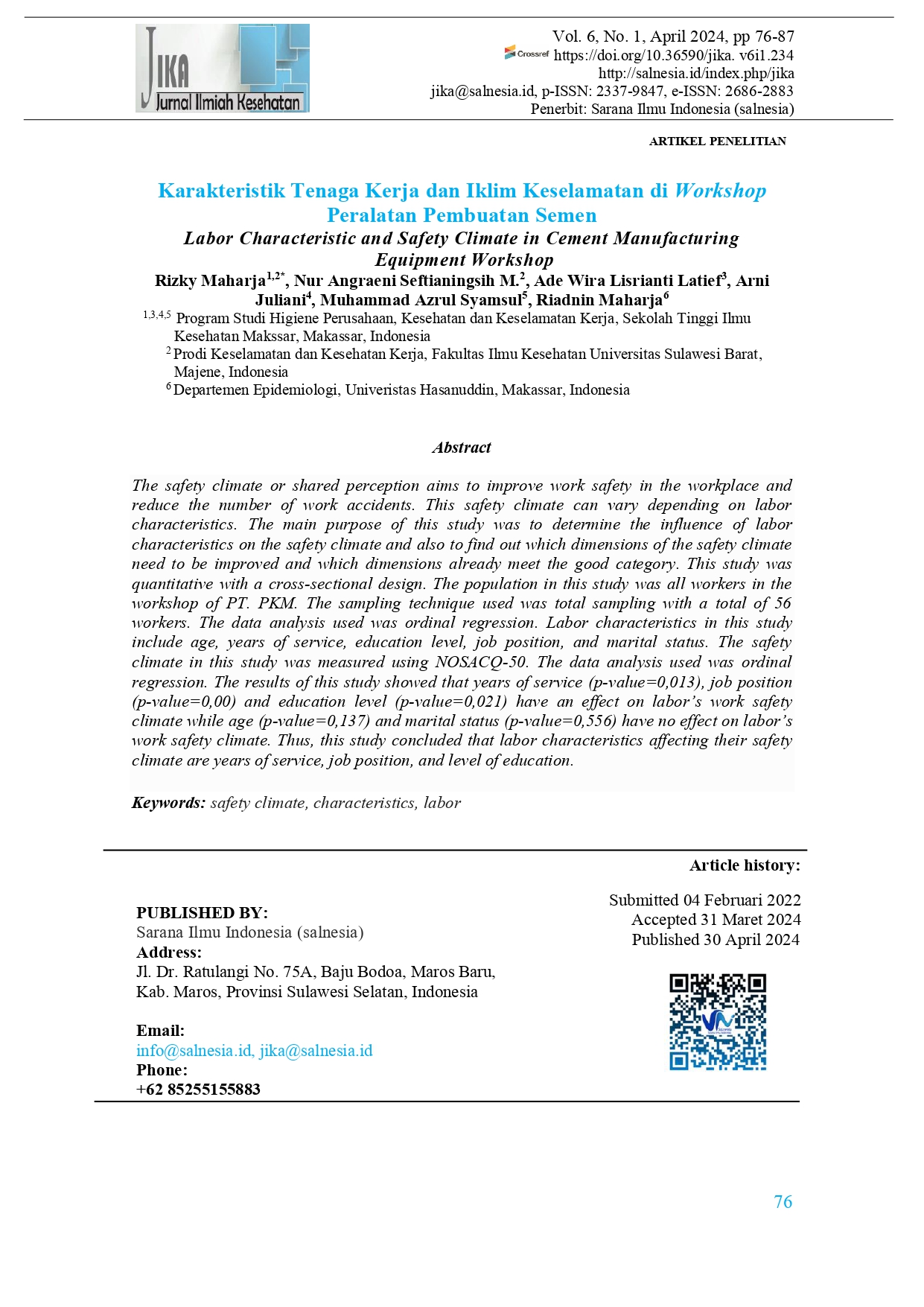Labor Characteristic and Safety Climate in Cement Manufacturing Equipment Workshop
DOI:
https://doi.org/10.36590/jika.v6i1.234Keywords:
safety climate, characteristics, laborAbstract
The safety climate or shared perception aims to improve work safety in the workplace and reduce the number of work accidents. This safety climate can vary depending on labor characteristics. The main purpose of this study was to determine the influence of labor characteristics on the safety climate and also to find out which dimensions of the safety climate need to be improved and which dimensions already meet the good category. This study was quantitative with a cross-sectional design. The population in this study was all workers in the workshop of PT. PKM. The sampling technique used was total sampling with a total of 56 workers. The data analysis used was ordinal regression. Labor characteristics in this study include age, years of service, education level, job position, and marital status. The safety climate in this study was measured using NOSACQ-50. The data analysis used was ordinal regression. The results of this study showed that years of service (p-value=0,013), job position (p-value=0,00) and education level (p-value=0,021) have an effect on labor’s work safety climate while age (p-value=0,137) and marital status (p-value=0,556) have no effect on labor’s work safety climate. Thus, this study concluded that labor characteristics affecting their safety climate are years of service, job position, and level of education.
Downloads
References
Akbar R. 2020. Pengaruh Pengalaman Kerja terhadap Produktivitas Kerja Karyawati PT Bank Rakyat Indonesia (Persero) Tbk. Kantor Cabang Polewali. [Skripsi]. Universitas Negeri Makassar.
Det Nationale Forskningscenter for Arbejdsmiljø. 2021. Safety Climate Questionnaire - NOSACQ-50. Det Nationale Forskningscenter for Arbejdsmiljø. https://nfa.dk/da/Vaerktoejer/Sporgeskemaer/Safety-Climate-Questionnaire-NOSACQ50
Dewi AI, Wardani E. 2022. Occupational Health and Safety Management System and Work-Related Accidents Among Hospital Nurses. Elsevier, 2(2): S6-S10. https://doi.org/10.1016/j.enfcli.2022.03.008
Hasibuan CF. 2018. Evaluasi Penerapan Safety Climate Menggunakan NOSAQ-50 di Perusahaan Perkebuhan PT XYZ. Elkawnie, Journal of Islamic Science and Technology, 4(2): 15-26. http://dx.doi.org/10.22373/ekw.v4i2.3597
Huang H, Wang X, Hu G. 2016. Traffic Safety in China: Challenges and Countermeasures. Accident; Analysis and Prevention 95(Pt B), 305-307. https://doi.org/https://doi.org/10.1016/j.aap.2016.07.040
International Labour Organization. 2019. Dalam mengahadapi pandemi: Memastikan Keselamatan dan Kesehatan Kerja di Tempat Kerja. International Labour Organization.
Maharja R, Tualeka AR, Suwandi T. 2018. The Analysis of Safety Culture of Welders at Shipyard. Indian Journal of Public Health Research and Development. Indian Journal of Public Health Research and Development, 9(11): 544-548. https://doi.org/10.5958/0976-5506.2018.01513.9
Marin LS, Lipscomb H, Cifuentes M, Punnet L. 2017. Associations Between Safety Climate and Safety Management Practices in The Construction Industry. American Journal of Industrial Medicine, 60(6): 557-568. https://doi.org/10.1002/ajim.22723
Mirsan A. 2021. Tahun 2020 BPJamsostek Catat 397 Kecelakaan Kerja di Sulsel. Sulsel Fajar. https://sulsel.fajar.co.id/2021/03/08/tahun-2020-bpjamsostek-catat-397-kecelakaan-kerja-di-sulsel/
Nadhim EA, Hon C, Xia B, Stewart I, Fang D. 2018. Investigating the Relationships Between Safety Climate and Safety Performance Indicators in Retrofitting Works. Construction Economics and Building, 18(2): 110-129. http://dx.doi.org/10.5130/AJCEB.v18i2.5994
Parinduri AI, Ginting R, Sirait I. 2021. Pengaruh Pemberian Safety Talk terhadap Kepatuhan Penggunaan Alat Pelindung Diri (APD) pada Perkerja Batu Bara. Jurnal Kesehatan Masyarakat dan Gizi, 3(2): 177-181. https://doi.org/10.35451/jkg.v3i2.649
Poursadeqiyan M, Arefi MF, Khaleghi S, Moghaddam AS. 2020. Investigation of The Relationship Between The Safety Climate and Occupational Fatigue Among The Nurses of Educational Hospitals in Zabol. Journal of Education and Health Promotion, 9: 1-9.
Prihatiningsih S. 2017. Analysis of Safety Climate Profile Among Paper Machine Operator Uncoated Division at PT. XYZ in 2017. [Skripsi]. Universitas Indonesia.
Silvia S, Ihsan T, Rizky IA. 2020. Analisis Iklim Keselamatan Kerja dan Pengaruh Karakteristik Responden pada Bagian Produksi di PT . X. Serambi Engineering, 5(3): 1155-1164.
Sucipto. 2014. Kedewasaan dalam Akad Nikah dalam Perspektif Interdisipliner. Jurnal Hukum Ekonomi Syariah, 6(2): 38-53. http://ejournal.radenintan.ac.id/index.php/asas/article/view/1722/1439
Sukapto P, Djojosubroto H, Bonita B. 2016. Evaluasi Iklim Keselamatan Kerja dengan Menggunakan Metode NOSACQ-50 di PT. Primarindo Asia Infrastruktur Tbk. [Makalah]. Simposium Nasional RAPI XV: Surakarta, 143-49.
Tampubolon DP. 2020. Analisis Iklim Keselamatan (Safety Climate) Karyawan Tambang Bawah Tanah Deep Mill Level Zone PT. Freeport Indonesia Mimika Papua. [Skripsi]. Universitas Pembangunan Nasional: Jakarta.
Wisnugroho ADH, Dharmastiti R, Hidayat M. 2019. Pengaruh Usia, Jenis Kelamin, Status Pendidikan, dan Masa Kerja terhadap Persepsi Iklim Keselamatan dari Pengemudi PT XYZ Yogyakarta. [Prosiding]. Seminar Nasional Gotik, 374-383.
Zadow A, Dollard MF, Parker L, Storey K. 2019. Psychosocial Safety Climate: A Review of The Evidence. Psychosocial safety climate. Springer, Cham. http://dx.doi.org/10.1007/978-3-030-20319-1_2

Downloads
Published
How to Cite
Issue
Section
License
Copyright (c) 2024 Rizky Maharja, Nur Angraeni Seftianingsih M., Ade Wira Lisrianti Latief, Arni Juliani, Muhammad Azrul Syamsul, Riadnin Maharja

This work is licensed under a Creative Commons Attribution 4.0 International License.








